Here we are at last, at the end of Alucard’s route — and, by tragic happenstance, the worst stage in the game. Block 7 on the “main” route has the unfortunate distinction of being a genuinely poor piece of game design, entirely reliant on tedious waiting, extended pattern memorization, and flawless traversal of gimmicky stage mechanics. It also lacks any new or interesting mechanical or visual elements, consisting of retread tiles from the previous catacomb stages as well as the falling-object features seen in Blocks 5 and 6.
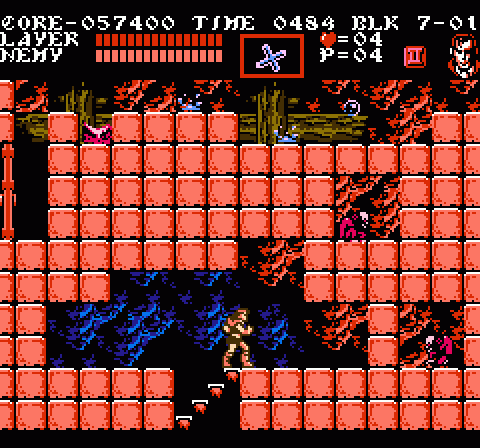
It actually starts out quite strong. The second screen of the stage features this interesting application of the block-dissolving acid drops from before. Instead of eating away the blocks that comprise your route, here they create your path forward. They also unleash a threat in the form of the Flea Man above, who is probably out of range of most of your weapons. When the acid breaks through its chamber, it’ll drop down and attack. It create a welcome sense of tension in an otherwise passive sequence. Yes, you have to stand there and wait for the acid to work its magic, but you can’t afford to just stand around, because at some point the Flea Man is going to drop down and leave you a very short window in which to react.
Of course, you can totally just kill the one on the right immediately.
Alas, it starts to go downhill from here. Which is strange, seeing as the motif of this stage involves climbing upward.
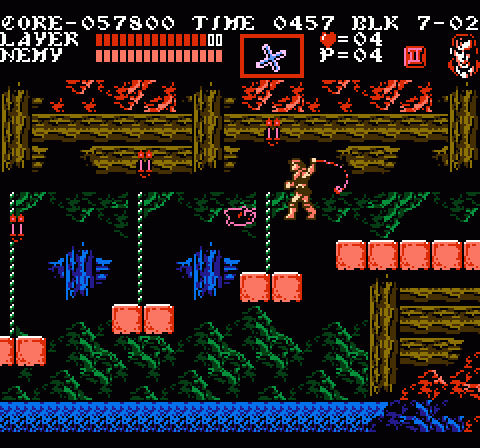
Block 7-02 isn’t too bad. It even shows a touch of classic Castlevania architectural consistency with a series of blocks suspended by cables from timbers shoring up the caverns. The bulk of this block takes place in the foundations and along the cliff face outside of the castle (if you check the map, a large portion of the structure sits on a rocky overhang above the lake), and the first half of the block mostly involves traveling through the interior sections.
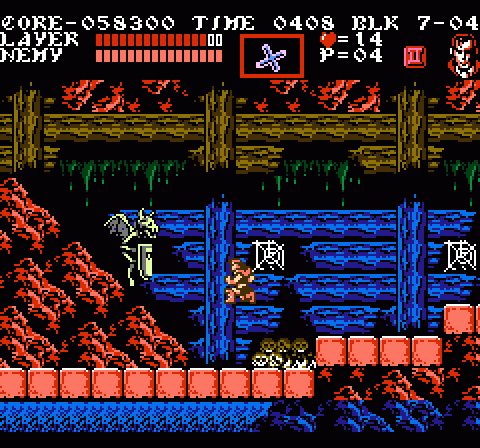
The Gargoyles seen elsewhere in Sypha’s ratcheting tower appear for the first time in this route, used in a very different way. When we saw them before, they were sent to harass you as you slowly made your way up stairs; in this instance, though, you’re moving across a horizontal space, and their chaotic sine wave pattern forces you to time your movement to avoid being clobbered from an awkward angle.
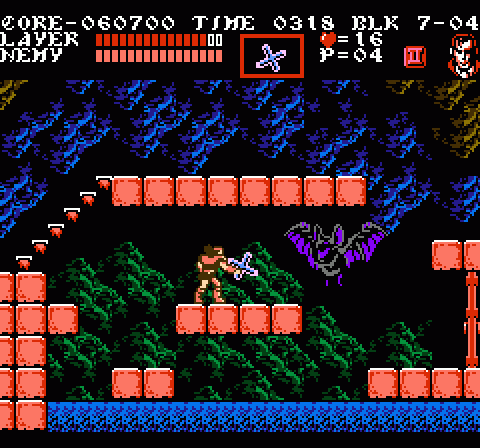
At the end of Block 7-04, you face off against another instance of the bat boss you fought at the end of Alucard’s Block 4 — the only instance in the entire game of the same boss showing up twice along the same route. It’s much easier this time around, though, as you have much more room in which to maneuver. You can basically stand by the door to the lower right and chuck axes for a no-sweat victory.
Of course, it’s probably for the best that the bat is so easily defeated, because at this point you’re unfortunately only halfway through the stage — and this has been the easy half.
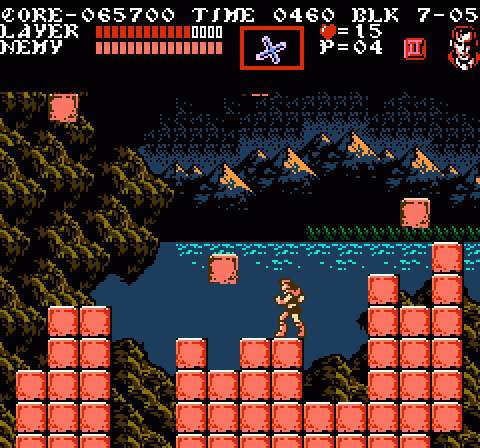
Here’s where Route 7 goes badly off the rails. Outside the castle, the only way to ascend the lakefront cliff is to climb blocks. This is a reprise of the falling blocks that appeared in Block 5, except here it’s not an obstacle but rather the only way to advance. The use of falling blocks creating a staircase actually showed up slightly earlier in this block as you needed to let blocks drop to give you a foot path to a door high on the left side of the screen, but here it’s taken to an unfortunate extreme.
The problem with this sequence is that it’s incredibly protracted — it takes a couple of minutes for enough blocks to drop to let you reach the exit above. In that time, the blocks fall in a pattern; they’re not random, but there’s practically zero time to move out of the way once a block appears on-screen. So you’re forced to memorize the pattern and respond to it, over and over again, until you finally reach the top. It’s a long, tedious process fraught with room for error yet which offers very little clemency.
You can of course totally breeze past it by turning into Alucard and flying to the top, but that assumes you’ve chosen Alucard as your companion rather than sticking with Grant, going it alone with Trevor, or doing a second-quest runthrough with Sypha (in which case there’s even less room for error given the higher damage you suffer from being hit by a block the second time around). The fact that the only way to make this sequence not a toilsome chore is to rely on an optional character seems like a huge design misstep. It might not even be entirely terrible if this stage had been one of the optional spurs of Alucard’s Block 6 — if you could take on either this level or the ruins, say — but unfortunately it’s a mandatory challenge regardless of which path you take on this route.
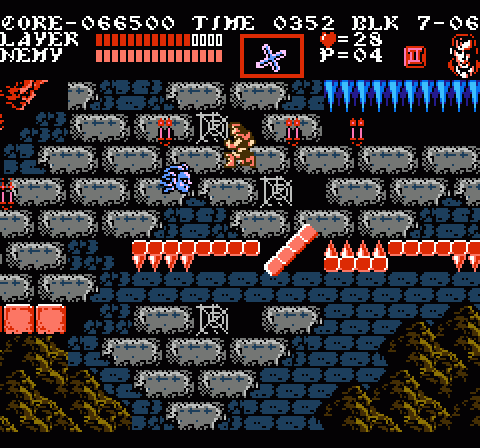
The next sequence would be maddeningly difficult under other circumstance, but after the block climbing episode it actually comes off as a bit of a relief for its reliance on old-fashioned mechanics. You ride a series of moving platforms across open chasms, after which you have to traverse a lengthy expanse of flip traps while being harassed by Medusa Heads. This might actually be the redeeming feature of this stage; you’ll remember the Medusa Head and flip trap combination from the very first block, but here it lacks anything like clemency. There’s only a tiny span in which you can accidentally drop through a spinning trap without plunging to your death… and several of the blocks flip over to create spike hazards, so even if you don’t fall you’re boned regardless.
Theoretically, you could also bypass this with Alucard, but the tight sine pattern of the Medusa Heads combined with the abundance of spikes about the area make even the bat trick a dangerous proposition.
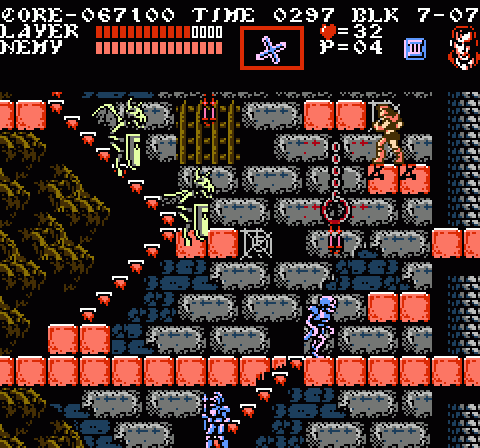
Finally, the last section of Block 7 ends with another auto-scrolling sequence filled not only with durable foes and gargoyles and crumbling blocks. There’s much less room for error here than in any previous tower ascent.
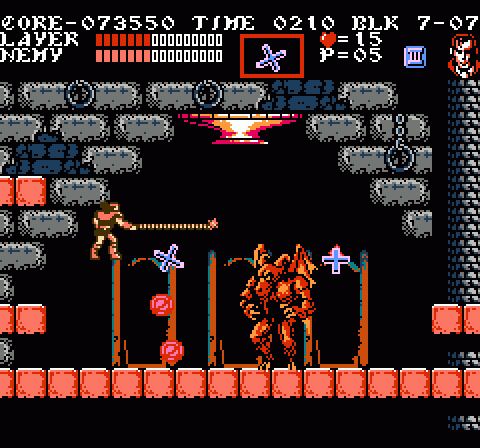
And, at the end of it all you have to face the same three-part spirit boss gauntlet that ends Sypha’s route. This part really shows the relative boss-crushing capabilities of Trevor’s companions. The gauntlet was total cake with Sypha and, say, the lightning spell; here, it’s downright demoralizing in its difficulty. There’s no easy solution unless you’ve somehow managed to make it this far with a triple boomerang or holy water or something (as in the image) — and even then you only have one shot at it, because the 7-07 tower climb doesn’t offer enough goodies to beef up Trevor’s crew to that level again. And, of course, if you don’t manage to make it all the way through the rough going of the auto-tower and three bosses in a row, you’ll run out of lives and have to do this entire block all over again.
Persevere, however, and you’ve completed Alucard’s route. You’re in Castlevania itself, and you can rest assured knowing that while the road ahead is no cakewalk, nothing to come compares to the hair-pullingly horrendous design of the gauntlet you’ve just completed. Hallelujah.
Yeeeeep. The concept of nerd rage may not have existed in 1990 but oh man :l
Added hilarity: Game Center CX https://www.youtube.com/watch?v=HTpSGJyHHQs
The falling blocks look familiar. I think I may have played this stage before at some point, though I never got far in it.
The auto-scrolling and Kid Icarus-esque memory devouring ascents always felt bizarre in Castlevania III and Super Castlevania IV. These games built up at least a somewhat grounded setting where a guy who looks like Conan the Barbarian in leather beats the crap out of Dracula, Frankenstein’s monster, the Grim Reaper, and lot of flying Medusa heads with a whip that turns into a flail, and there’s clearly a lot of love for scenery, but death by scroll kill or forgotten lower ground just feels a lttle too video-gamey for a setting like this.
Oh well, at least a few other games were better at explaining why lower ground equals death with some kind of hazard, whether it’s Ninja Gaiden 3’s rising lava or Castlevania Bloodlines’ flooding water.
You fight the Cyclops three times on Sypha’s route, and the mummy duo twice.
Anyway, the block climb is definitely the most tedious, agonizing part of the game (aside from maybe how the U.S. version handles the final boss), but it does a great job of conveying your ascent from caverns to a castle up on a cliff. Still, I always either fly through it or cling to the side until it’s stacked high enough.
I meant the bat is the only time you fight the same boss encounter exactly. I’m aware of the cyclops and mummies (please refer to the articles I have been writing!) but those always add something new.
Wow am I glad I never got to this part. Jesus H. Christ.
The falling block climb is where I threw in the towel. Even with Alucard, I couldn’t get past it for some reason- I think I kept getting hit by blocks, or I just didn’t have enough hearts. It’s been so long, I don’t even remember what happened.
GCCX: “5 hours of playing Stage 7 have passed.” Ha!
I hate, hate, HATE this block. Not only are the mechanics and gimmicks in the level tiresome and annoying, but they completely obliterate the consistent architecture thing that you’ve been praising throughout this article series. Why did the acid in the one block have to wait until Trevor got into Castlevania to start dissolving bricks? How in the hell did the Fleamen get trapped in there? Where are the bricks falling from in the other block and why are they doing so in such consistent patterns?
These block falling/dissolving puzzles were bad and annoying in Zelda II and they’re even worse here. Waiting for blocks to fall is never fun.
The falling blocks are always where I ragequit a replay on the Alucard route.